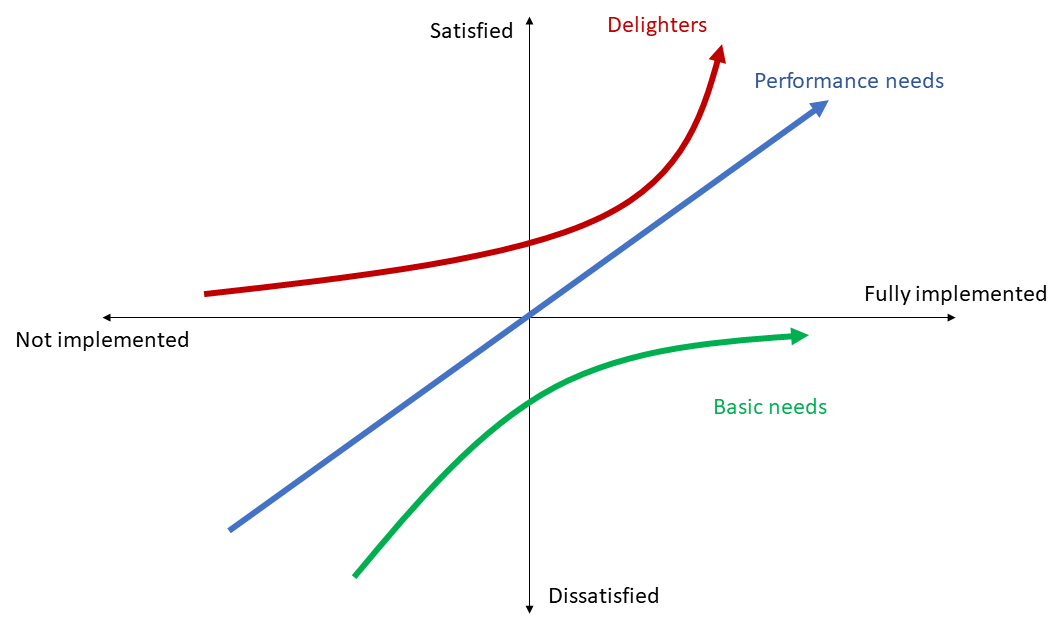Appearance
Kano Model
- Subject
- Delivering business and customer value
- Participants
- Agile coach, Product Owner, Developers
- Facilitator
- Agile Coach / Agile Master

Summary
The Kano method is used to determine and classify factors that make customers happy and to measure the concept of customer satisfaction.
Definition
The starting point of the Kano method is the customer perception:
How does a customer or a dedicated group of customers perceive different performance features of the product or service? To get significant information, the target customer group must be narrowed down as precisely as possible. By taking the respective customer requirements into account you can identify and classify the priority of the individual product or service features. The Kano model demonstrates that these expectations my change in time or by target group.
The three most important categories from the Kano Model are:
Must-be Quality / Base factors: Requirements that are expected by the customer and are often not specifically communicated. Only if you cannot fulfill them, will you be noticed and this inevitably leads to dissatisfaction.
(e.g. a four-star hotel in a mediterranen region is supposed to have air conditioning. The customer won't ask for it, but will show his displeasure if it is missing)
One-dimensional Quality / Performance factors: These are easier to spot. The customer is aware of them and they are clearly expressed (e.g. in a specification document). Customer satisfaction increases depending on the degree of fulfillment of the requirements. On the other hand, unfulfilled requirements lead to customer dissatisfaction. A possible competitive advantage depends on the degree of fulfillment.
(e.g. a hotel promoting its spa area will lead to satisfied clients, but if its out of order it will lead to dissatisfaction.)
Attractive Quality / Enthusiasm factors: Requirements that not assumed or expected by the customer. The customer does not expect them as they are unknown. Enthusiasm factors are an additional benefit that clearly differs from other competitors. Even a minimal increase can bring disproportionate added value. Enthusiasm factors are often the basis for a unique competitive advantage (unique selling proposition (USP))
(e.g. your car manufacturer provides an over the air update for your car with new software for your engine and battery management and you increase reach by 10%)
There are to other categories: Indifferent Quality and Reverse Quality.
While for the category of 'indifferent quality' the customer just does not care if the feature or service is available at the category 'reverse quality' having a feature or service may in fact decrease customer satisfaction (e.g. too many buttons and functions on a smartphone app)
Motivation
On the basis of the findings from the Kano Model, you can optimize products or services in such a way that the best possible customer satisfaction is achieved in a targeted, specific customer segment.
Results
You focus on customer needs and valuable features to satisfy the customer and increase outcome of your product or service.
Benefit
The requirements that customers expect from a product can be identified using the concept of the Kano model. A prioritization enables the company to invest to the most valuable properties, features or services what leads to an outcome optimization.
Procedure
In agile product development, there are different prioritization practices.
The focus-dimension, the product owner should be aware of, is expected customer satisfaction. Applying this method, the product owner can identify the importance of product backlog items. Therefore the agile coach or master should work together with the product owner on following questions and statements:
Is the feature mandatory?
Having this feature, will the customer say: 'Hey, that's nice! I like it and it seems to be really helpful'.
This feature is excitement! This feature is indifferent.
It doesn't matter if this feature is or is not implemented.
This feature is really doubtful.
I am not sure if I will pay for product with such a feature. It will probably not help me at all.
These questions may be collected in a questionnaire and thus verified by the customer or end-user. To get a complete picture the questions should be formulated in a positive way (How would you feel if the product had ...?) and in a negative way (How would you feel if the product did not have ...?)
Source: https://agilefellow.com/2014/11/25/kano-model-discussion-at-the-tampa-bay-agile-meetup/
Tools
Whiteboard / flipchart / standardized questionnaire
Hints
It is advisable to use standardized questionnaires to minimize the influence of the interviewer on the respondent. Either paper or online questionnaires might be used. An alternative are interviews with a standardized questionnaire.
See also
Roland Jochem, Dennis Geers Kundenanforderungen - Kano Modell QZ-online,N. Kano, N. Seraku, F. Takahashi, S. Tsuji (1984) "Attractive Quality and Must-be Quality" In: Journal of the Japanese Society for Quality Control. 14(2), S. 147-156